You might think you know how to jump start a car, but do you know the right way to jump start a car? Don’t worry, because I’ve got you covered. If you’re lucky enough and take good care of your car, you might not have to jump-start it for years.
But hey, accidents happen, and if you ever find yourself in a situation where you need to jump-start your own car, you’ll be glad you know how to do it.
Learning how to jump-start a car yourself isn’t difficult, with a little knowledge and following a few simple steps, you can get back on the road in a minute.
All you need are some trusty jumper cables, also known as booster cables, to connect the dead battery in your car to a fully charged battery in another vehicle. It’s a smart move to keep a good set of cables, along with other roadside emergency gear, in your car’s trunk.
Read on to learn the steps to jump-start a vehicle with a dead battery.
6 Steps: How to Jump Start a Car
To safely jump-start, you’ll need a few things before you start. First, you’ll need a set of jumper cables. Second, you’ll need a fellow driver who is willing to lend a helping hand.
1. Park Both The Vehicle
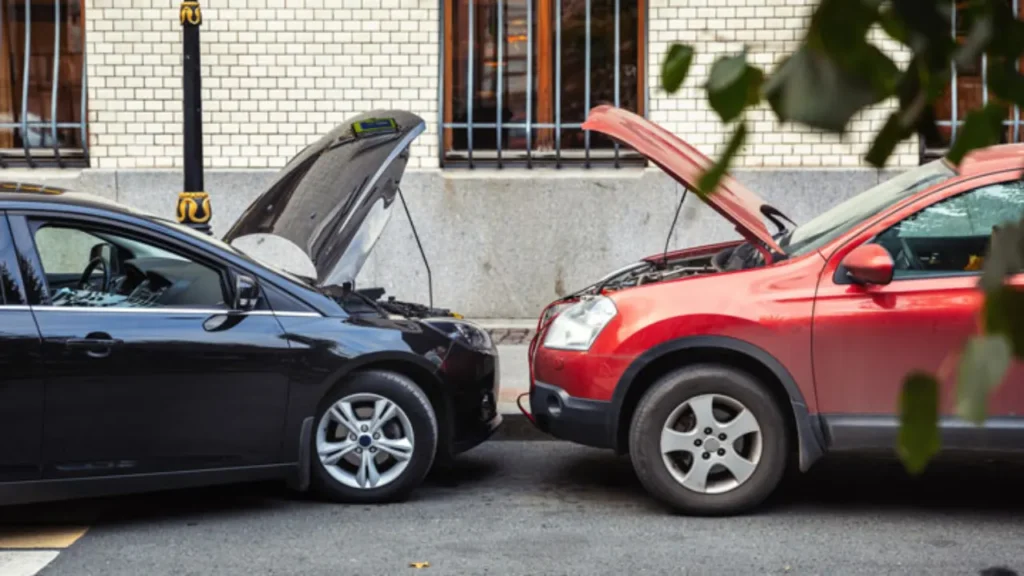
First, find another car with a full battery and park it near your car. They can be side by side or facing each other, as long as the jumper cables can reach both batteries.
Turn off the engines on both cars and take out the keys. Make sure to engage the emergency brake in both vehicles. Also, switch off anything that uses power, like the AC, lights, and radio.
Bonus Tip: Most cars have the battery under the hood, but some models have it in the trunk or under the back seat. Just position the car with a working battery accordingly. If you’re not sure where the battery is located, refer to the vehicle’s manual for guidance.
2. Locate the Battery Terminals
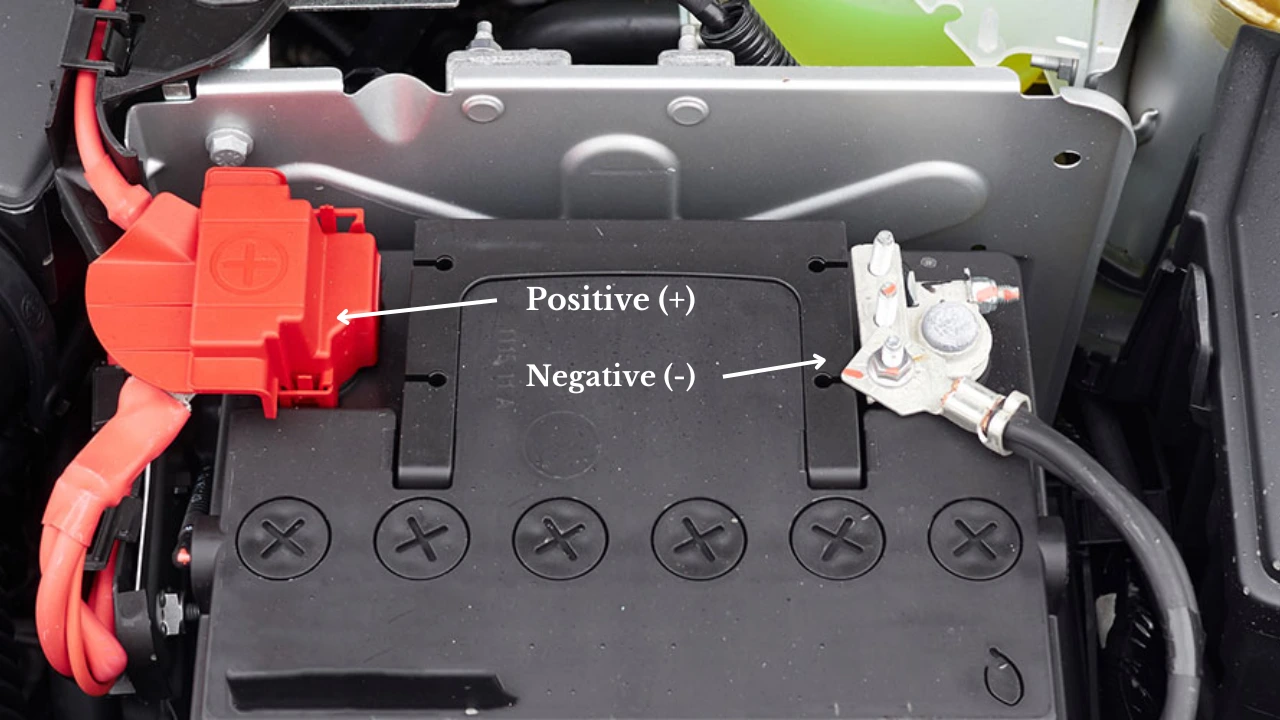
Now it’s time to open the hoods of those cars and get to the batteries. You’ll find two metal terminals on each battery—one positive (+) and one negative (-). If the battery terminals are hidden, no worries!
There are usually some remote metal posts for easy access to jump-start or give it a boost. Look out for a red cap on the positive terminal. Refer to the vehicle manual for terminal locations if necessary.
Make sure those terminals are nice and clean. If you see a white or greenish gunk coating the posts, grab a wire brush, aluminum foil, or anything except your bare hand to remove it.
Trust me, you don’t want that stuff irritating your skin. Oh, and one important thing—don’t even think about jumping the battery if it’s cracked or leaking.
3. Connect the Jumper Cables
When you’re using jumper cables, you’ll find a pair of clamps at each end — one is red, and the other is black. The red one goes on the positive battery terminal, while the black one is for the negative or grounding post. Makes sure we connect everything securely and in the right order. We don’t want any personal injuries or damage to the car’s electrical system, right?
Make sure to keep the ends from touching each other while you’re clipping onto the batteries.
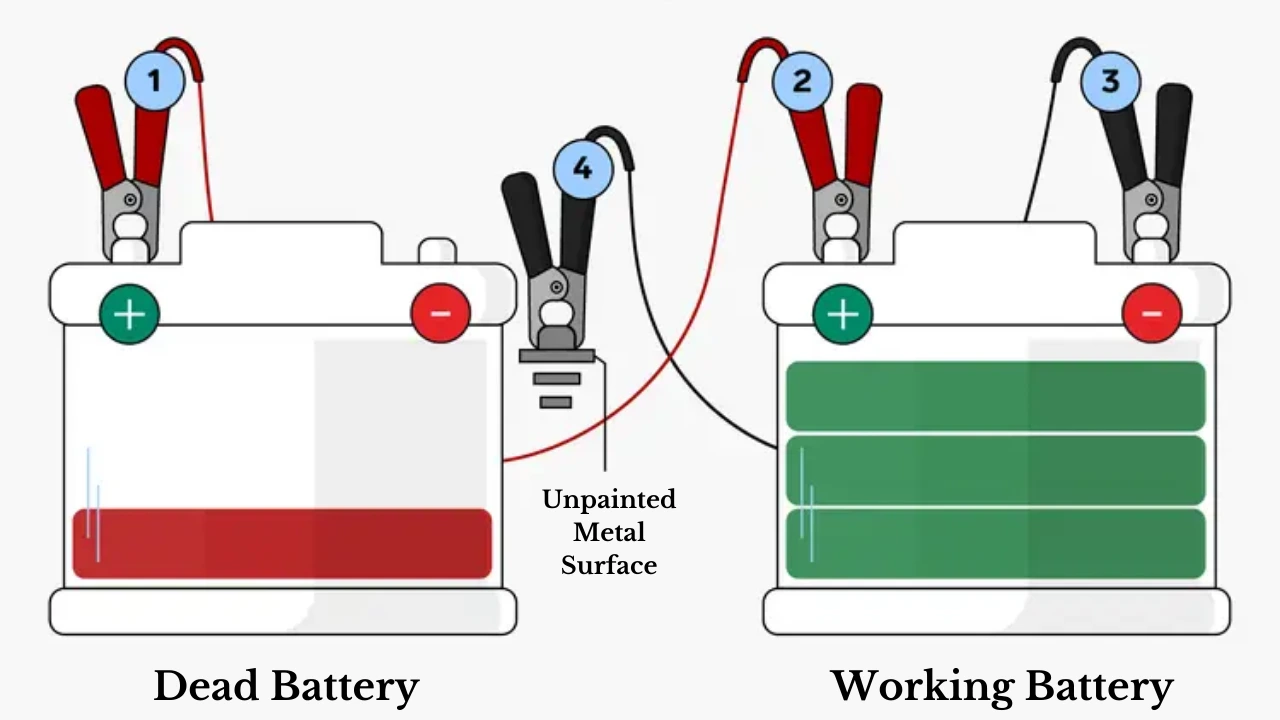
- Start by hooking up the red (+) clamp to the positive terminal of the dead battery.
- Next, connect the red (+) clamp to the positive terminal of the working battery.
- Now, attach the black (-) clamp to the negative terminal of the working battery.
- Finally, connect the remaining black (-) clamp to an unpainted metal surface of the dead car. Some models have a specific grounding bolt marked with a (–) just for this purpose.
Bones tip: make sure the metal parts on each clamp are touching the metal part of each battery terminal post. we want a good connection, Right?
4. Jump-Start the Car
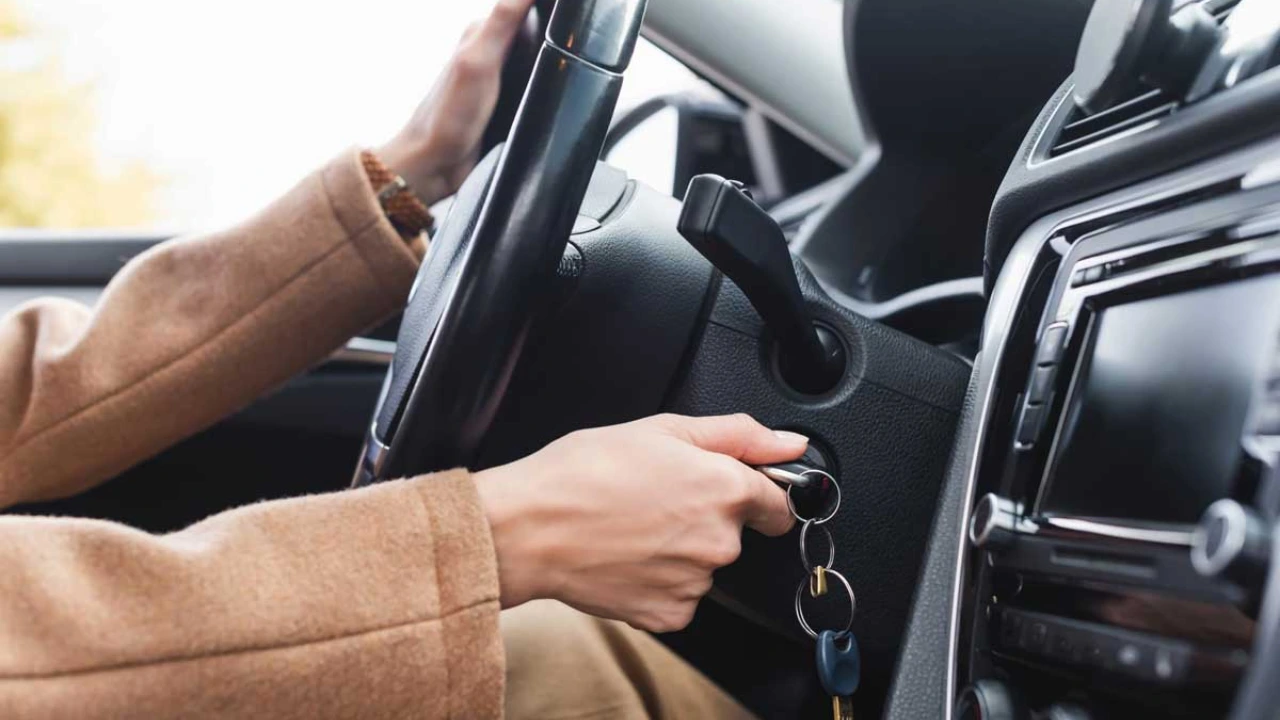
Start up the car that has the charged battery and let it run for a couple of minutes. Then, head over to the car with the dead battery and crank that key until the engine fully starts. It might take a little while for the dead battery to start drawing power from the other vehicle.
If the engine is a bit stubborn and doesn’t start, try revving up the engine of the booster car. Sometimes giving it a little more juice can help get things going faster.
Bones tip: If you’re wondering whether you can jump-start a car in the rain, relax—it’s perfectly safe. Even with the extra moisture, the voltage of the vehicle’s battery isn’t high enough to make the task any more dangerous than jump-starting on a dry day.
5. Remove the Jumper Cables
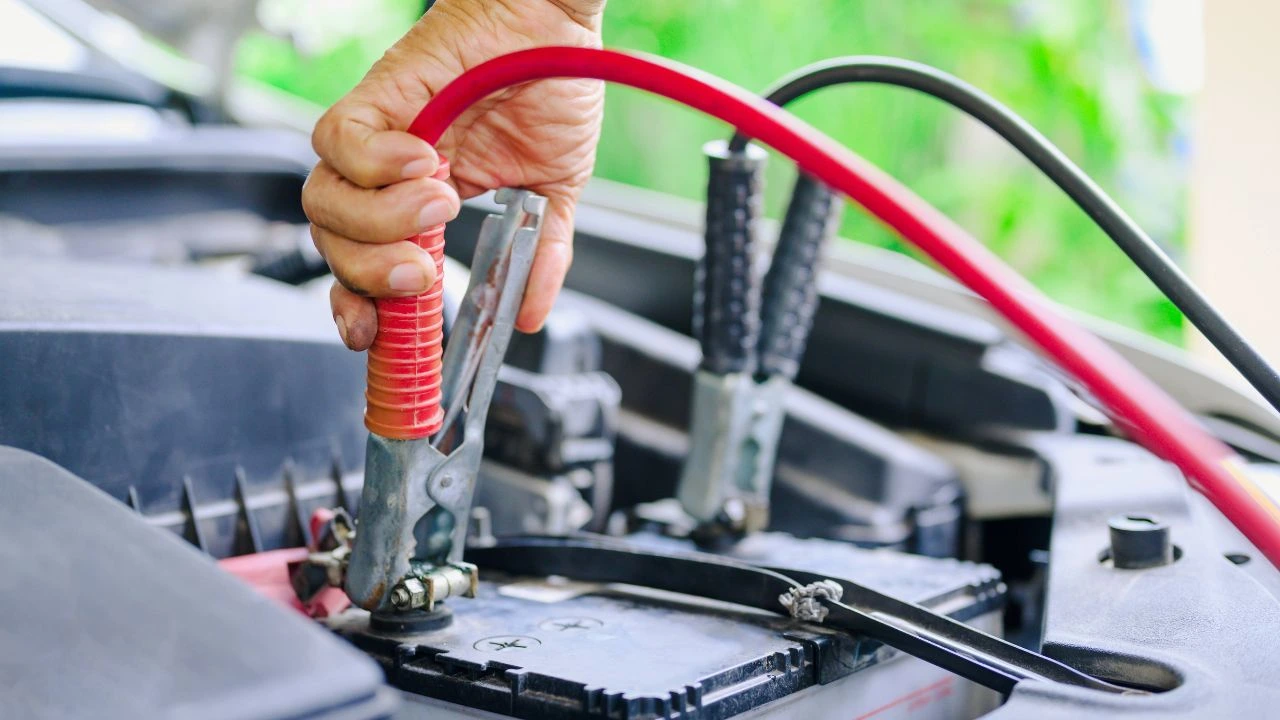
Leave both cars running, and remove the cables in the reverse order of how you attached them. Make sure the metal clamps don’t touch each other while connecting or disconnecting them from the battery terminals.
- Start with disconnecting the black (-) clamp from the car that received the jump start.
- Next, disconnect the black (-) clamp from the booster car.
- Then, remove the red (+) clamp from the booster car.
- Lastly, disconnect and take off the red (+) clamp from the car that received the jump start.
Once all the clamps are off, you can roll up the jumper cables and put them bake in your kit, and close the car’s hood.
6. Drive the Jumped Car

Let the revived car engine run for several minutes at least or drive for at least 15 minutes, if possible, to allow the alternator to charge the dead battery. Park the car in an open area of a safe location in case the car needs jump-starting again.
If the battery you jump-started is older than 3 years, it’s a good idea to get it tested. They can check if it’s still holding charge. And if there are other issues causing the battery to die, take the vehicle to a mechanic to have it inspected.
How to Properly Jump Start a Car?
If Your Car Won’t Jump Start
What if the car won’t jump start? Well, there could be a few reasons why your jump-starting efforts are falling flat.
- Hear that clicking noise? Your starter might be acting up.
- Is your electrical system still kicking? It could be your ignition switch, battery, starter, or even a fuse giving you trouble.
- Did your car give up right after a successful jump? Give it another shot, but make sure you let your vehicle run for a bit longer afterward. That’ll give your battery a chance to recharge more fully.
How to Use a Portable Jump Starter on a Dead Car Battery?
It’s often better if you purchase a portable jump starter than if you have jumper cables. With the jumper box, you don’t need anyone else to help you get the battery powered back up. All you need to do is make sure the jumper box is charged up, which can be done easily overnight with a regular household outlet.
Before you use the portable jump starter, make sure you read the instructions included with the model you have. Each one can be slightly different.
However, here are some simple instructions on how to start a dead car battery with a portable jump starter:
- Connect the positive cable from the jumper to the battery’s positive terminal.
- Connect the negative cable from the jumper to the battery’s negative terminal or to an unpainted metal surface on the engine block. Do not allow the two jumper cables to touch one another.
- Secure the jump box in a location where it’s not going to fall.
- Turn on the jumper box.
- Try to start your vehicle. You may need to wait a few minutes until the charge is provided.
- Once the engine is running, disconnect the negative cable.
- Disconnect the positive cable last.
You should follow our previous guidelines about driving the car for at least twenty minutes after the vehicle starts. This time allows the battery to recharge from the power of the alternator.
How to jumpstart a car without cables or another car? (Only For Manual Transmission)
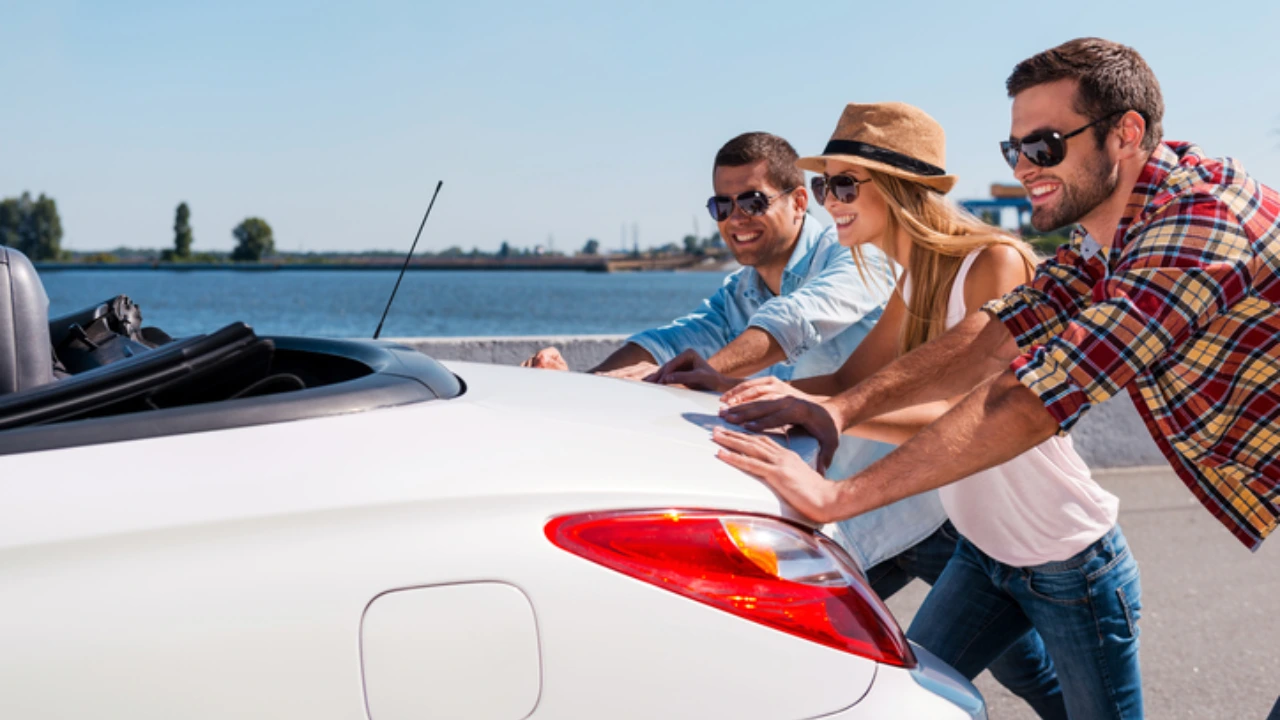
- Find a hill or get some people to help push the car. We need a little momentum to kick things off!
- Push the clutch pedal all the way down. We want it on the floor!
- Pop the car into second gear. Not first, not third—just right!
- Time to get the key in the ignition but hold off on starting the engine. Turn on the ignition but don’t start the engine. This is also known as key position two. The key is inserted and turned one step to the right. Turning one step further would start the engine, which you don’t want to do.
- Alright, release the brakes and keep that clutch pedal down. We’re going to start coasting down the hill or with a little help from our friends.
- Once we hit around 5 mph (8.0 km/h), then release the clutch pedal. At that point, the transmission will turn the engine over enough for it to start. This method usually works. If it doesn’t, try pressing and releasing the clutch again.
What happens if you connect the negative battery terminal first?
Unless you make a mistake, connecting the negative battery terminal first will make no difference.
However, if you connect the negative terminal first, because there is negative charge in your car’s chassis, there is a risk of sparks and short-circuiting the battery if you touch the chassis with the positive terminal.
Why don’t you connect the negative terminal when jumping a car?
It is better to connect the negative jumper cable to a clean metal surface, such as a grounded bolt, as there is less risk of igniting the battery acid fumes with a spark.
If you ignite the battery acid fumes, it can cause the battery to explode, resulting in serious injury or even death.
How long should you jump a dead car battery?
Depending on the size of your battery and the jumper cable size, you may need to jump it for anywhere from 30 seconds to 3 minutes before making a starting attempt. Once the car is started, let it run for at least 15 minutes to give the battery a chance to recharge.
Why do you connect the positive terminal first?
You connect the positive terminal first because the body of the car is negatively charged, and if you connect the negative jumper cable first, you risk touching the body with the positive battery cable. This will create sparks that can lead to fires or explosions if you’re unlucky.
Having the knowledge of how to jump-start a car is very useful when out on the road and a knowledge that every car driver should have. It’s actually quite simple and if you learn it once, you’ll probably remember it for the rest of your life.
I hope you enjoyed this guide and now have the knowledge to start any car if you find yourself in this situation.
FAQs.
Can you jump a hybrid car battery?
Yes, just like standard vehicles, a hybrid can jump-start when the battery is discharged. HEVs have two batteries: A 12-volt battery — like a traditional car battery — and the more robust setup that powers the electric motor.
Can You Jump Start a Car with A Bad Starter?
If you’re dealing with a bad starter in your car, jumping it might give you a temporary fix, but it won’t actually solve the real problem. When you jump-start a car, you’re just giving the battery a boost, not fixing the starter itself.
I mean, yeah, the battery does send power to the starter through a relay, so a jump start can sometimes give the starter that extra kick it needs to get your engine running. Trust me, relying on jump-starting your car every morning is not a sustainable solution.
How Long Does It Take to Jump-start a Car?
If you’re going to jump-start your car by yourself, you can expect the process to take about 10-15 minutes. But If you have a professional jump-start your car, then it might take a little less time. If you need a battery inspection performed, then that shouldn’t take more than 10 minutes as it’s a straightforward process.
How long should I let the working vehicle run after jump-starting?
After getting a jump, you should leave your car running for at least 30 minutes. For more reliable results, drive it around instead of letting it idle. This should fully charge the battery, so it won’t die on you again.
Can I jump-start my car using a different type of vehicle, such as a motorcycle or a truck?
Yes, you can jump-start your car using a different type of vehicle, such as a motorcycle or a truck. A quality fully charged motorcycle battery of 10Ah or over will easily start any vehicle up to the size of a pickup truck. It may be a struggle with diesel though.
Can You Jump Start A Car In The Rain?
Yes, you can jump-start a car in the rain and it’s safe if you take precautions. Water conducts electricity, so it seems that it would be unsafe. However, a car runs on 12 volts of DC power with an amperage of 48 to 50 Ah.
These are safe ranges to work with, even when you are in the rain. Still, you need to keep the rain from hitting the open terminals of the jumper wire and use caution while connecting everything.